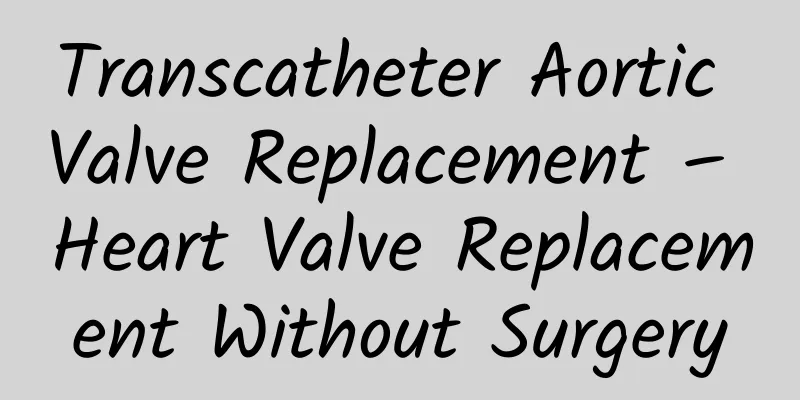Transcatheter Aortic Valve Replacement – Heart Valve Replacement Without Surgery

|
Author: Wang Shan Department of Cardiology, Xuanwu Hospital, Capital Medical University Reviewer: Xia Jinggang Department of Cardiology, Xuanwu Hospital, Capital Medical University The heart is one of the most important organs in the human body. It is like the engine of the human body, responsible for supplying fresh blood to organs and tissues throughout the body. Abnormalities in the heart will threaten health and in severe cases will directly lead to the death of the patient. As the age increases, if the patient has symptoms such as angina pectoris, dizziness or syncope, difficulty breathing, sudden death, sweating and palpitations, it may be that there is a problem with the heart. Our heart has "four doors", that is, four valves, which control the flow of blood in the heart, keep it in one-way circulation, and provide sufficient blood to the human body. The aortic valve is a very important valve that connects the heart to other important organs in the body. Generally, this door has three leaflets. If the aortic valve is narrowed due to some special reasons, it is like the window of the room you live in can only be opened a crack, and you in the room cannot breathe enough fresh air. In the long run, it will seriously affect the heart's blood supply to the whole body. In the early stages of aortic valve disease, the heart has a certain compensatory ability. It will increase the heart's contraction ability and use greater force to squeeze blood out of the "narrow gate" of the aortic valve. However, this compensation is limited. When it reaches a certain level, the heart can no longer bear it and it will damage various "parts" of the heart, causing heart fatigue or decreased exercise tolerance. In severe cases, the heart, the "engine", may directly go on strike, causing sudden death. Figure 1 Copyright image, no permission to reprint 1. Symptoms and hazards of aortic valve stenosis Aortic stenosis is a common heart valve disease. With the arrival of an aging society, the prevalence of aortic stenosis increases with age. According to epidemiological surveys, the incidence of heart valve disease in my country is 2.5% to 3.2%. Among them, the incidence of valvular heart disease in the elderly over 75 years old is as high as 13.3%. Aortic valve stenosis can be caused by sequelae of rheumatic fever, congenital stenosis or senile aortic valve calcification. In my country, it is highly prevalent among people over 65 years old. For patients with symptomatic severe aortic valve stenosis who do not undergo valve replacement treatment, the 2-year mortality rate is 50%. 2. The role of ultrasound examination Ultrasound examination is an important screening and evaluation method for valvular heart disease. Ultrasound examination is simple and easy to perform, and cardiac color Doppler ultrasound is the only instrument that can visually display valvular lesions. Through color Doppler ultrasound measurements, doctors can understand the extent of valvular lesions to decide whether to use conservative treatment or surgical treatment. Cardiac ultrasound examination can not only assist the clinical team in further evaluating the patient's condition, but also measure the patient's valve structure, which can timely determine the progression of the disease and the condition of other tissues, providing an important reference standard for the selection of clinical surgical timing. 3. Treatment of aortic valve stenosis Figure 2 Copyright image, no permission to reprint Surgical treatment is the only effective method for patients with severe aortic stenosis. In order to further determine the treatment plan, whether to perform surgery or minimally invasive surgery, the treatment should be carried out according to the plan given by the team of cardiologists and surgeons. Traditional surgical operations require splitting the sternum (wounds of more than 20 cm) to expose the heart, and the heart needs to be stopped during the operation, using an extracorporeal circulation machine to temporarily replace the heart to supply blood to the human body. Although low temperature and protective fluid are used to protect the heart during the operation, cardiac arrest will more or less damage the heart, especially when the operation time is long. Transcatheter aortic valve replacement (TAVR) was born in 2002. Currently, more than 400,000 operations have been completed in more than 65 countries around the world. It is a mature and safe operation. TAVR not only has a smaller surgical wound, usually only about 1 cm, but more importantly, the heart does not stop beating during the operation and does not require extracorporeal circulation, which greatly reduces damage to the heart. TAVR is safer and can also be performed on elderly, weak, multi-comorbidity, and poor cardiac function patients. Compared with surgical operations, it has the advantages of being more minimally invasive, faster postoperative recovery, and higher patient tolerance. For some patients, the operation can even be performed under local anesthesia and sedation. Patients can generally be discharged from the hospital 3 to 5 days after surgery, and can gradually resume daily physical activities after discharge. IV . T AVR valve lifespan The artificial valve currently used in TAVR uses nickel-titanium and cobalt-chromium alloys as the skeleton and biological valve leaflets (the same material as surgical biological valves). Implantation of the TAVR valve does not affect the patient's MRI examination. The native valve will be removed during surgery, but during TAVR surgery, the native valve is not removed, but is squeezed to the side by the new valve; surgery uses needles and threads to sew the new valve to the heart, while TAVR mainly uses the support provided by the aortic root structure to fix the new valve. At present, the general service life of TAVR valve is 10 to 15 years. At that time, the valve may fail, causing valve regurgitation or stenosis. However, this process is gradual and will not occur quickly, causing danger to the patient. The patient can find valve failure through ultrasound examination or seek medical treatment due to symptoms. After valve failure, the patient can undergo TAVR again, and another TAVR valve can be inserted into the failed TAVR valve for treatment. 5. Is anticoagulation therapy required after TAVR? TAVR uses biological valve leaflets, which have good tissue compatibility and will not be rejected. If the patient does not have other complications that require anticoagulation, he or she only needs to take one antiplatelet drug after surgery, such as aspirin or clopidogrel. If combined with diseases such as atrial fibrillation, anticoagulation therapy is required, such as new oral anticoagulants (such as rivaroxaban) or warfarin. The main role of antithrombotic therapy after TAVR is to prevent ischemic events such as valve thrombosis and stroke. Patients should strictly follow the doctor's instructions and should not increase, decrease or stop taking medication at will. 6. Outpatient follow-up plan after TAVR Figure 3 Copyright image, no permission to reprint 7. Postoperative Recovery 1. Avoid strenuous exercise within 3 months after surgery. Do indoor activities first and then outdoor activities according to your physical condition. Do what you can so as not to cause palpitations or shortness of breath. Do appropriate physical exercise according to your physical condition 3 months after surgery. You can do appropriate aerobic exercise, such as walking, brisk walking, cycling, Tai Chi, etc., which can improve endurance and enhance myocardial contractility. Figure 4 Copyright image, no permission to reprint 2. Quit smoking completely, avoid strong alcohol, limit drinking to small amounts of low-alcohol alcohol, and drink less coffee and strong tea. 3. Avoid overwork and get enough sleep.** In winter, keep warm and avoid catching a cold .** Do not take a bath after a meal or when you are hungry, and the bathing time should not exceed 20 minutes. 4. Eat a light diet with low-salt, low-fat, low-cholesterol, high-protein, high-fiber foods; the food should be diversified, with high-quality protein, calcium, vitamin C, etc., and eat more fruits and vegetables; eat small meals frequently as the principle, do not overeat at each meal, and overeating is strictly prohibited to avoid increasing the burden on the heart. Figure 5 Copyright image, no permission to reprint |
>>: This article will help you understand pain knowledge and eliminate misunderstandings
Recommend
What does a full gynecological examination include?
Because gynecological diseases are prevalent in r...
I have diarrhea every time I have my period.
Every girl's body is different, and they will...
Home rehabilitation for elderly people with dementia
It is estimated that by 2050, the number of peopl...
Why is there always water flowing from a woman's vagina?
A woman's body will undergo a series of chang...
What diseases are women prone to when they are too thin?
Nowadays, thinness is considered beautiful, many ...
What should I do if my 22-year-old breasts are underdeveloped? What are the treatment measures of traditional Chinese medicine?
Nowadays, there are countless breast augmentation...
Women with these 4 characteristics are the sexiest
1. Beautiful Legs Generally speaking, the knee is...
Why is it that the follicles are not discharged after they have grown?
Many female friends will have some gynecological ...
Can I use moxa sticks during menstruation?
No, moxibustion patches can invigorate blood circ...
How much does McDonald's Alexander Wang Black Gold Bucket cost? What does McDonald's Alexander Wang Black Gold Bucket contain?
McDonald's is a popular fast food restaurant....
What are the causes of female infertility?
According to traditional Chinese thinking, contin...
Treatment of menstrual fever and cold
During menstruation, women's immunity will au...
How big does the follicle need to be to make pregnancy easy?
Pregnancy is the happiest thing for a couple, bec...
Why is my menstrual flow so light?
Menstruation can be said to be a woman’s best fri...









